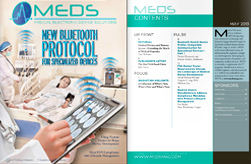Component suppliers need to understand why a developer selects one silicon product over another. For example, what features are needed in a blood pressure monitor vs. an ultrasound scanner? For the developer (OEM), the need is to understand the design criteria, the best design technique, the best design tools and the best components available to get the job done. For example, what FDA or ISO requirements are relevant when they launch a product? The design tool supplier needs to understand what the developers want in terms of features and functions to shorten their time-to-market. And finally, the contract manufacturer (CM) must understand the requirements the developers (OEMs) have when they choose a CM. For example, what other things are important besides ISO 13485 certification?
There is much to learn from the USB technology development. During the early days, I was asked this question over and over again by the USB developers, “When will USB become a standard?” Before USB became a household word, seven companies established the USB Implementers Forum to drive the development of USB. Numerous USB Developers Conferences and “Plugfests” were held worldwide to train the developers to create products to achieve “universal operability.” During these Plugfests, members representing different product categories in the ecosystem whether they were software, silicon, boards or devices, all met to plug their “gears” together. More often than not, there would be incompatibility and everyone would spend time in private meetings to sort out whether the problems were caused by the Microsoft Windows Operating Systems, the device drivers or, sometimes, the silicon cycle timing. Then everyone would go home and fix the suspected problem. All would come to the next Plugfest to do this again until every issue was fixed. I still remember the cheers from the crowd when USB successfully connected 127 devices without crashing the Microsoft Windows Operating System (no blue screen) for the first time. USB made history!
Today, the medical electronics community is in search of the knowledge and the best practices in delivering the best products FAST, much like what USB did. In response to such demand, RTC is adding an addendum, Medical Electronic Device Solutions (MEDS), to focus on the development, test and manufacturing solutions for medical devices. MEDS will interact with the medical electronic community by interviewing the leaders and innovators for the best practices and solutions. We will share that knowledge with the community and invite developers and other solution providers to ask questions and share ideas.
This issue will cover design considerations in silicon, software design, safety and applications in medical electronic products and healthcare. We would like to invite you to join us in search of the best Medical Electronic Device Solutions!
John Koon has worked in the electronics industry for over 30 years and has managed many software, hardware and silicon products. He started publishing about 16 years ago when USB 1.1 first came out. (Publications include USB Technology and Market Reports: version 1.1, 2.0, USB On-the-Go, and Wireless USB). Besides speaking at various conferences, Koon has contributed articles for magazines like Electronic Design, EDN, USA Tech and Product Design and Development.

